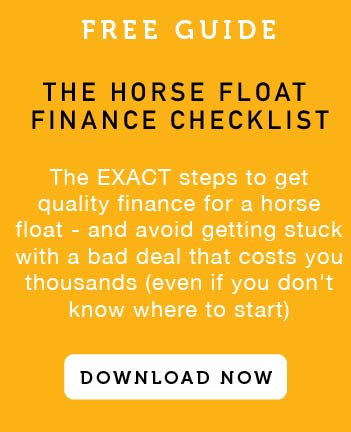Towing a Horse Float requires additional knowledge and skill. All Horse floats, trailers and caravans affect the performance of the towing vehicle. They affect fuel consumption, acceleration, braking ability, general control and maneuverability. These effects worsen as the size and weight of the horse float increases relative to that of the towing vehicle.
The extra length and width can be hard to manage, with wind, road roughness and passing vehicles having a greater effect than on the vehicle alone. This puts additional responsibilities on a driver.
The information on this page applies to vehicles not exceeding 4.5 tonne gross vehicle mass (GVM).
Rules for towing
Towing more than one Horse Float at a time is not allowed. Nobody is allowed to ride in Horse Floats, trailers or caravans. When towing and driving on a road without street lights, drive at least 60 metres behind heavy vehicles or other vehicles towing trailers, unless overtaking. Learner drivers and learner and provisional motorcycle riders are not allowed to tow. P1 car license holders can tow small trailers with up to 250 kg of unloaded weight.
The driver
Driving with a Horse Float takes practice. Remember:
- Allow for the Horse Floats tendency to ‘cut-in’ on corners and curves.
- Allow longer distances for braking,overtaking and joining a traffic stream.
- When reversing, it is advisable to have someone outside the vehicle giving directions.
- Avoid sudden lane changes and changes of direction.
- Look further ahead than normal so you can react to changes in traffic or road conditions.
- Use the accelerator, brakes and steering smoothly and gently at all times.
- Use a lower gear when traveling downhill to increase vehicle control and reduce strain on brakes.
- Slow down well before entering corners and curves.
- Horse Floats tend to jerk the back of the vehicle around and can cause sway (snaking). If a Horse Float starts to sway, the vehicle’s brakes should not be applied, except as an absolute last resort. If the Floats brakes can be operated by themselves they should be applied gently, otherwise a steady speed or slight acceleration should be held if possible until the sway stops.
- Take care not to hold up traffic unnecessarily.
- Plan more rest stops and shorter traveling days as towing is more stressful and tiring than normal driving.
- There is no specific speed restriction while towing a Horse Float. However, the posted speed limits must not be exceeded.
- Always drive to the road,traffic and weather conditions.
Before each trip,
Check:
- Vehicle and Horse Float are roadworthy.
- All tyres are properly inflated.
- Floats wheel-bearings, suspension and brakes work properly.
- All lights work and safety chains are properly connected.
- Oil, water, brake fluid, battery and other service checks on the vehicle.
At regular intervals during the trip, check:
- Couplings, all doors, hatches, covers and any load or equipment are still properly secured.
- Tyres are still properly inflated and not rubbing on suspension or body work.
- If traveling to another State, check with the relevant roads authority whether there are different rules.
Towing Hitch for towing a horse float safely.Vehicles must be suited to the trailer. Vehicle manufacturers usually indicate in the owner’s manuals the maximum weight and other features of trailers appropriate for the vehicle. These limits should not be exceeded. If unsure we recommend that you contact your local manufacturer or retailer of the Horse Float you are looking to purchase.
Registration:
All vehicles must comply with all relevant standards for registration and be roadworthy at all times. Rear number plates and lights must not be obscured by the tow bar when there is no trailer connected.
Towing vehicles must be properly equipped with:
- Tow bars and couplings of a suitable type and capacity.
- Electrical sockets for lighting.
- Brake connections if the trailer is fitted with power or electric brakes.
- Additionally: Extra mirrors may be needed for the towing vehicle if towing a large Float.
- For vehicles with automatic transmission, an extra transmission oil cooler may be needed.
Some vehicles need structural reinforcement and/or special suspension and transmission options and load-distributing devices to be able to tow heavier Floats.
TOW BAR
A properly designed and fitted tow bar is essential for towing. The rated capacity of the tow bar and coupling should not be exceeded. The tow bar should be clearly and permanently marked with its: Maximum rated capacity. Make and model of the vehicle it is intended for or the manufacturer’s part number. Manufacturer’s name or trade mark. This is compulsory for vehicles built after 1 January 1992. The exception is where the tow bar is a permanent part of the vehicle. Tow bars must not protrude dangerously when there is no float or trailer connected.
LOAD EQUALISERS
Load equalisers can be used when towing large Horse floats or caravans. Load equalisers: Help the vehicle retain normal suspension height and effective steering control. Transfer some of the weight from the towbar to the front and rear suspension of the vehicle. As load equalisers may overload the towbar and its components, check with the towbar manufacturer for advice before use.
THE HORSE FLOAT
Horse Floats must be of a suitable size and type for their intended tasks. They must be built to meet the standards for registration. If a horse float is required to be registered it must be fitted with a rear number plate and a registration label holder and current registration label mounted as close as possible to the number plate.
TOWING RATIO REQUIREMENT
The loaded mass of the trailer must not exceed the lesser of: Rated capacity of the towbar and tow coupling. Maximum towing capacity of the vehicle. Maximum carrying capacity of the trailer. Maximum rated carrying capacity of the tyres.
If the vehicle manufacturer has not specified the maximum towing mass, the maximum towing mass is: One and a half times the unladen mass of the towing vehicle, provided that the trailer is fitted with brakes which are connected and in working order, or the unladen mass of the towing vehicle if the trailer does not require brakes.
Vehicles with a manufacturer’s gross combination mass (GCM) more than 4.5 tonne may tow in accordance with the above requirements.The GCM is the gross combination mass of the car and loaded Horse Float.
Once again we recommend that if you are in any doubt to contact your manufacturer or retailer of your horse float and discuss any concerns you may have.
BRAKING SYSTEM
The minimum braking system for a float depends on the type of Horse Float, its weight and the weight of the vehicle: 0 – 750 kg loaded weight – no brakes required. 751 – 2000 kg loaded weight – braking on both wheels on at least one axle. 2001- 4500 kg loaded weight – braking on all wheels, and an automatic breakaway system in case the trailer becomes detached from the vehicle. Brakes must be operable from the driver’s seating position.
TOWING COUPLING
All couplings: Must be strong enough to take the weight of a fully loaded trailer. Should be marked with the manufacturer’s name or trade mark and rated capacity. Must be equipped with a positive locking mechanism. The locking mechanism must be able to be released regardless of the angle of the trailer to the towing vehicle.
SAFETY CHAINS
Must comply with Australian Standards. Trailers less than 2500 kg when loaded must be fitted with at least one safety chain. Trailers over 2500 kg when loaded must be fitted with two safety chains. To prevent the front end of the drawbar from hitting the ground if the coupling is disconnected, safety chains must be: As short as practicable and connected to the towing vehicle. Crossed over if two chains are fitted.
LOADING OF HORSE FLOATS
It is important that Horse floats are not overloaded and that your horse and equipment are properly secured and or contained within the trailer. Your horses safety is of the utmost importance and therefore your float should be properly configured to ensure that you, your horse and all of your equipment have a safe and trouble free trip.



